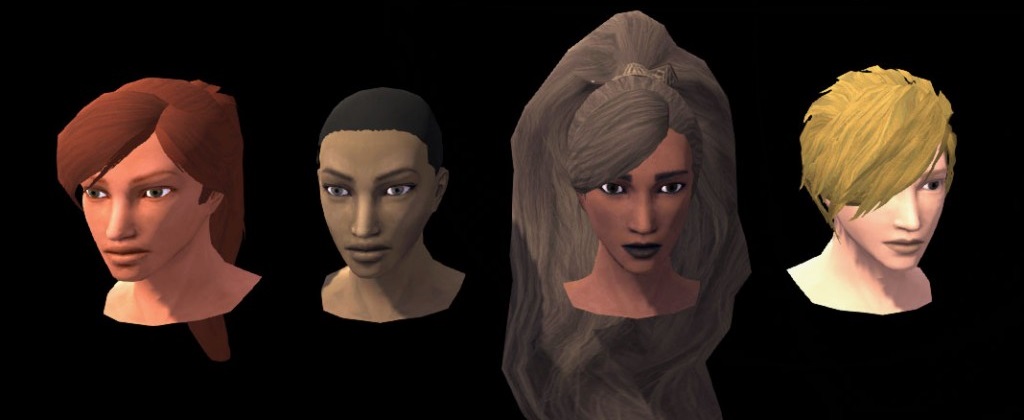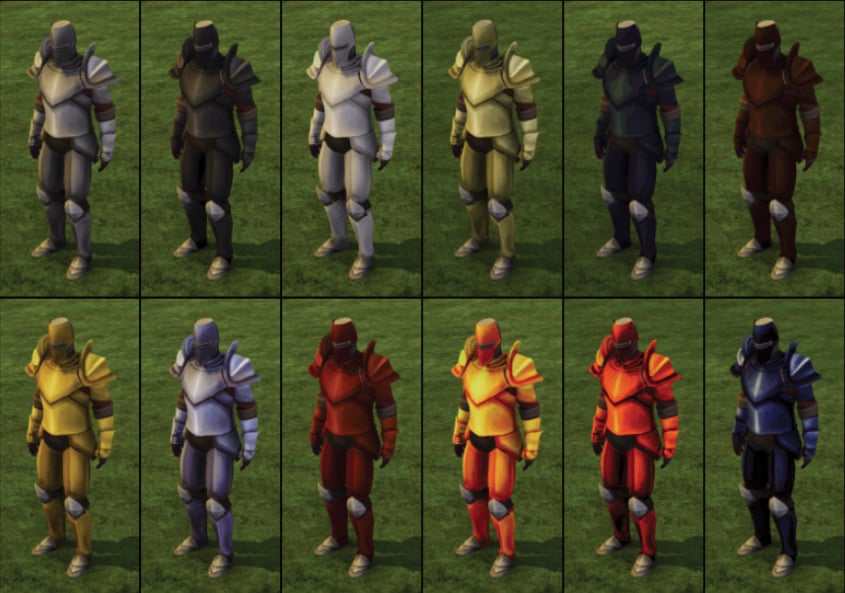
One thing I love about GDC compared to other conventions I cover is how many actual developers I get to talk to, especially without PR and Marketing handlers. Everyone has his or her job, I understand that, but my job as press it to cut through those two departments to get what the actual product is. Nothing helps that more than understanding the thoughts behind design decisions, and that can rarely come from people who aren’t keyboard deep in code and design docs.
My talk with Citadel Studios’ Founder and CEO Derek “Supreem” Brinkmann and Lead Designer Jeffrey “Miphon” Edwards felt like the right kind of interview for just that. I’m not someone who backed their project, and I’m not sure if Legends of Aria (formerly Shards Online) is my type of game, but after checking it out for myself, I feel like the game is in capable hands.
Designing post-Trammel PvP
I’ve gotten to talk to a lot of developers over the years, and I’ve found that a good developer knows not only his or her game but the genre and can talk about why decisions matter within the greater gaming context rather than just in his or her own personal development history. Brinkman and Edwards seem like the former, and nothing impressed me more than our talk about PvP. Brinkman worked on Ultima Online and Edwards has experience there and in Darkfall, so we were able to talk about things like why “gankbox” games work (at least for awhile, you have people who enjoy killing each other) and why they don’t (once the sides are established, newcomers are more like meat for all sides that don’t take the newbie under their wing).
And truth be told, people who enjoy gankboxes can really be fun. Oh, you may not like being ganked by them, but add something to the game. It was something echoed in Friday’s Ultima Online panel: People acting badly create memories. Those EVE heists we write about are a good example of that. The Elite Dangerous Salome event, WoW’s corrupted blood event, Asheron’s Call’s Shard of the Herald… all involved PvPers acting in cutthroat ways people didn’t expect. Some people were angry, but they mark times in gaming history when the devs couldn’t control the players, and that’s exciting.
But you don’t always want to be involved in that. Often, it’s more fun to watch from the sidelines, which is why AC’s Shard Defense felt like it was so easy to participate in without directly being involved. This is what led to our chat on iterating on past games’ PvP alignment systems. For those who don’t know, Legends of Aria uses a kind of flagging system called karma: Blues are innocents and reds are murderers who incur harsh enough penalties to induce PK (Player Killer) ire. Reds – people who kill blues and kill indiscriminately – are to be outcasts, stuck in outposts with travel punishments, but your average PK is “white.” Whites just fight amongst themselves (outside of alliance wars). They’re not punished for it. Think of flagging for PvP on your average PvE server. That’s easy enough to stomach, right?
Now let’s modify that. There are still PvP areas, and of course, that’s where the best stuff is. If you’re a PvE fan, it kind of sucks to go there, right? But what if people who killed you then risked exposing themselves to attack. I don’t mean something based on a time limit, but something they had to grind to get out of. And it’s not just for killing you, but for other things, like taking even a single item from your body, steepening that grind to return to safety. And since you’re in a profitable area of the world, your killer essentially turned himself into a walking piñata anyone can attack without retribution. Maybe that would help.
And so far, according to Brinkman and Edwards, it’s working. It’s different from flagging since it’s a spectrum. Citadel is currently seeing blues in PvP zones, but they’re not being PKed. Odder still is the fact that this is after Citadel reduced its guarded zones (high-sec) to only about a third of the map and expanded PvP zones (low-sec) to about two-thirds.
However, the rules of karma still exist, so it’s not unmitigated PvP. In fact, more ganking between karma classes is happening in towns than in PvP zones at the moment because of a bug. In the wild, the blues (non-PKs) are actively going into PvP zones, and although they can be killed, I’m told whites (neutral PKs) are sticking to killing their own kind or lower, with being red (PK) sounding like it’s something few people will really want to experience. It’s not that PvP has died; it’s migrated. A lot of the PKs have gone into the allegiance system that uses consensual PvP. If the team can get things right with the karma system, it wants to get rid of the guard system altogether, but that’s a decision for the future.
Normally I don’t buy this kind of line from a developer. However, the basic idea is one I’ve seen tried before and generally works until the innocents are incentivized (looking at ArcheAge’s trade routes here). Due to their experience, Brinkman and Edwards understand the Trammel issue from multiple angles, as developer and player, classic and modern gamer and designer. They understand the need for the wolves to not only exist but to exist in an environment the sheep can safely participate in, much like the Shard of the Herald event I’m always going on and on about. The karma system’s only been live for a short time, but it’s something I’d probably try if I made my own MMO!
Living up to the “Ultima Online successor” mantle
This is how we discussed the idea that Citadel doesn’t pick and choose what old school features to use or abandon – just which ones to iterate on. While some of the old school UI options were functional before, clearly it’s better to update them (and the team’s working on that already).
With this in mind, it should be obvious that the team doesn’t shy away from the UO successor title some people have thrust onto them. A big part of this comes from its sandbox approach. The idea is that, especially with WoW, designers started taking control of the players’ experience, min-maxing it based on their own thoughts. They create guided experiences.
Clearly, that’s not bad, as it not only opened up the genre to new players but improved usability. Citadel has learned from this as well. Anyone who has gone back to the early MMOs probably recalls readjusting to arcane UI decisions of the past, and LoA started off with some similar choices, like having to navigate a few menus to mount and dismount. Default actions for items in CB2 will occur with a double click, making the game less retro in the best way possible.
However, because theme park games are built on rails, stuff off the path may not really feel finished. In a LoA, the team still wants some of those on-the-rail moments, but it should lead to your own adventure. For example, an NPC might approach you with a mission, but since you don’t have that happening constantly, just finding that moment becomes part of the experience. It’s not a reinvention of the genre, but taking an old form and trying to add on new components to see how it changes.
That may not sound like much, but Edwards notes that after a person’s first character, she often doesn’t want to experience the game “organically” anymore. She’s willing to bang her head against the wall to max out stats or get that thing she’s already aware of. Being on the tracks not only means creating content to be consumed but also essentially, creating content that will largely be ignored as time goes on. Even as a player, I remember doing WoW‘s Molten Core for weeks and realizing that most of the gameworld was essentially useless to me at that point, which must crush the designers.
Again, Citadel sees the UO comparison as a development compliment: It’s making a virtual world, not a themepark. Quests still have their place, but the idea is to give people a sense of wonder. People are so used to glowing doors and guided “Press this!” displays that the modern gamer often doesn’t try to open a door or pick up a fishing rod without being prompted to do so.
That being said, when you go old school, you also risk old school problems, like with macros being abused for use-based skill systems. Despite my concern, Brinkman and Edwards are OK with macroing, if it’s attended. They want to make it hard, like making it so you can only skill up by using an ability to a certain degree before needing to practice that skill on something more difficult, but if you want to make it work, that’s fine, and seems fair enough to me. Realistically, they say that players will do as they please. The devs’ job isn’t to prevent that but to make it less ideal, which comes off as an incredibly grounded design goal.
Naturally, as Shards is one of the earlier Kickstarter MMOs, I had to ask how it’s been developing the game in such a public way. One thing Brinkman homed in on was how much the devs underestimated their work, but in a different way than they anticipated. Remember, Shards was originally a smaller game. Maps were literally supposed to be a certain size, and Citadel found out that it was just too small for people, even for people who had backed them, meaning the devs had to go bigger. Luckily, a lot of their supporters are fine with it since LoA is a game doing things not a lot of other MMOs are trying. People want Citadel to get it right, but naturally, there are still people wanting them to hurry up too!
I had to ask the team reps what EA means to them and why they aim to use it. I was told that, for LoA, EA is launch. It will probably have bugs, but LoA will be polished enough to be worth the money. After a short amount of time and feedback, once some more bugs are clean, it’ll leave EA. While I’d normally suggest going straight to launch, the guys are also a small indie group toeing the line between classic and modern design, so I won’t jump on them too harshly. In fact, recognizing how EA is viewed by consumers and having goals makes me far less suspicious of their intentions.
Closed Beta 2 and a double dose of content
As you may remember from the February reddit chat, beards are coming. I’m not sure what else the community could possibly care about besides that, but I’ll still outline some of the things the devs claimed fans might want to know about beyond the joys of facial hair.
Originally, the CB1 servers were going to be brought down at the end of the testing phase, but because there were streamers showing off the game and the playerbase seemed to want to keep playing, the servers stayed on. In that sense, CB2, which is coming in April, may seem like a patch, though be warned, as the “final wipe and launch are coming soon.”
Optimization is the big thing now. There’s been a new hire, and the goal is to make it so that the server doesn’t need to reset every two hours. What they’re aiming for is a daily, 2 a.m. reset. Not all the optimizations will be done for CB2, but the goal is to have a lot of the work done sooner rather than later.
However, before that, the team plans to release a kind of “CB 1.5” with some of the original CB 2 planned features at the end of March to celebrate PAX East. The team plans to give PAX players hands-on time with the game, online in all its MMO glory.
That might not seem like a big deal to those who haven’t attended a con, but so many MMO developers bring games/demos that aren’t online and/or multiplayer, which completely ignores the nature of the genre. What the demo may look like wasn’t shared, but if PAX demo characters are set to jump in game and do quick group content, there’s a good chance people might actually understand part of the beauty of MMOs.
That isn’t to say that past LoA demos don’t show off the game well. Brinkman and Edwards have mentioned that people who didn’t think they’d like the game because of its Ultima Online influence ended up liking it, not because LoA lacks UO’s old gankbox nature but because UO and games like it are about world interaction, not character progression, and that idea really struck me. As much as we love our characters, I feel like MMO fans want things to do with their characters. The grind needs to lead to something. Otherwise, we’d still just be grinding rats and goblins as our sole content, right?
For current players who are into fashion, good news! The devs have changed their dye system. The dyes should be less “old color + new color = hope for the best” and more “blue is blue.” In addition, they’ve been working on “color masking” to protect certain parts of items you dye, meaning that brown belt on your pants won’t turn green when you dye them.
Citadel is also slowly allowing more people to modify the game, which (in my mind) was one of the initial draws of the game. Don’t expect a deluge quite yet, though, as this will still be a rollout based on people who signed up during the initial crowdfunding campaign until the game’s launch. Hopefully, there’ll be a new way to launch your servers and sign up to participate in server modification in CB2 as they need the infrastructure for that first.
Again, I don’t know if Legends of Aria is really the game for me, but the design ideas are sound: They’re clearly balancing feedback with their design goals and aren’t afraid to build a niche game for an audience that’s been wholly neglected.



















